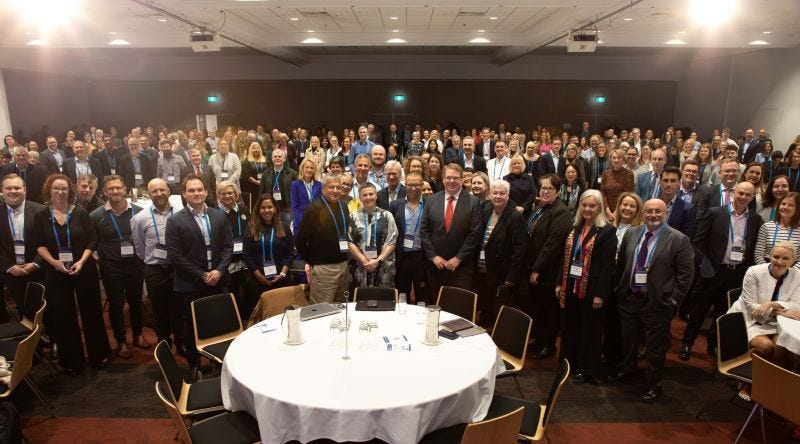When differences don't matter
Strategic group think
In the realm of strategy, we often shy away from groupthink. But what if there's a way to harness its power for breakthrough innovation?
At the helm of the Commonwealth Government's Primary Healthcare Conference this week, I noticed a surprising parallel with an unlikely source: Massively Multiplayer Online Role-Playing Games (MMORPGs).
Just as MMORPGs create virtual worlds where millions collaborate, strategise, and progress, this conference demonstrated how to leverage similar dynamics in the public value sphere:
Persistent Environments: Like the world of a MMORPG, the primary healthcare system doesn't pause when we "log off." It's a living, breathing ecosystem that continues to evolve.
Sub-Group Synergy: Like guilds in MMORPGs, diverse teams (practitioners, CEOs, activists & advocates, government officials) contribute unique perspectives to an overarching direction.
Social Interaction Drives Progress: Structured discussions, workshops, and informal networking propel ideas forward, much like collaborative quests in gaming.
We designed the conference for 300+ stakeholders across 33 sessions over 3 days, focusing on three big strategic ideas:
Integration - System redesign focussed on team-based care models, enabled by blended and flexible financing.
Innovation - Harnessing data and AI for insight-driven interventions that are leadable by multi-jurisdictional groups with shared interests.
Change - Deliberately investing in the capability to navigate transformative shifts (e.g., human change readiness uplift, co-created roadmaps, innovation and learning hubs) so both incremental improvements and disruptive advancements achieve dramatic pay-offs.
The result? A palpable sense of momentum, optimism, and concrete ideas for systemic change. One eminent speaker referred to the mountain of paper that has been built around un-acted upon proposals over decades; he said (and I agree), “This feels different”.
Question: How do you use the power of a (large) group to progress a big idea?
Rock, paper, scissors
One of the conference’s presenters quoted doctor, government advisor, and company director, Steve Hambleton: “If funding is in conflict with a model of care, the funding always wins”.
What he means is that if a doctor is paid to provide a service (say a Medicare funded consult), she will do that. Now, if she knows the patient needs more, she might use discretion to extend the consultation but, ultimately, the funding model will win, as her next patient is patiently waiting their turn for their 15 minutes.
Therefore, we need to create funding settings that give flexibility to practitioners, in the moment.
One such system, presented at the conference, solved the problem of wait lists for ‘rapid intervention’ mental health issues. The solution was that a practitioner would alternate pre-booked half hour slots, with ‘same day’ half hour slots. This means they could see 10 - 14 people a day, half of whom would get same day appointments. Under this model, too, patients only came on average three times for a rapid intervention, and then reported no further need.
Even if you’re not in health care, or human services of any sort, the strategic principle remains: ensure that how your people are paid for attending to your customers is in line with how you want them to behave.
Question: How do you remove tensions between your “funding model” and your “customer model”?
Do what works
Another pervasive theme at the conference was the idea that we should default to using data to prove the social and economic benefits of any public healthcare investment.
And, just recently, the Australian Treasury launched its Australian Centre for Evaluation, which has the job of helping departments and agencies do just that: put evaluation evidence at the heart of policy design and decision-making.
The raison d’etre of this group is confidence creation: so government knows it’s investing wisely, and so the public knows its government is. Now before you imagine that these are statistical nerds in an ivory tower who number crunch meaninglessly, think about whether, as a tax-payer, you’d support these instances of saving (or even makes) money, while delivering better outcomes:
In Victoria (where I live), offenders were given dramatically simplified summons information. Instead of a 2200 word document, they got a 60-word statement with hyperlinks. Result? Better court attendance, and fewer arrests for non-appearance.
In Mexico, the Progresa/Oportunidades Program gives people modest cash amounts to spend on health and education. A randomised controlled trial in 500+ communities showed that school enrolment increased, health was better, to the point that 30 countries have now tried this approach.
The UK's Behavioural Insights Team (BIT) have tested different framing of tax collection letters, again using randomised controlled trials. This has increased tax collection by 15% and, again, has been adopted by other countries.
Question: How can you deliberately evaluate whether your initiatives deliver better outcomes and value for money (and could potentially be used by others)?
You know what I’m going to suggest, don’t you? If you got this far, just click the heart. I love to know that you’re out there — the loneliness of the newsletter writer is a well known phenomenon!
Seriously, though, I hope you travel through your week looking for ways in which society is improved through collective effort (especially when it’s based on evidence of what works), and drop me a line if you see great examples.
Until next Friday, enjoy the sunshine wherever you are,
Andrew



Thanks for chairing a thought provoking and focussed conference. While it is yet to be seen/ developed what changes will eventuate, the sense of direction and hope was a nice change!
Loved the reframing discussion. Hmmm how could rates notices look different?